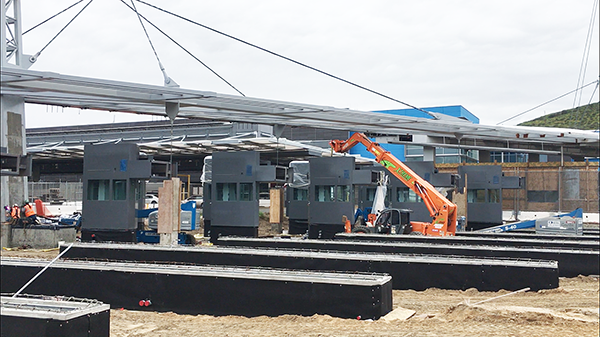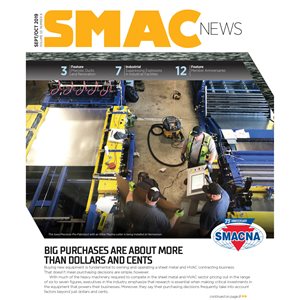California Sheet Metal Takes on Challenges to Make the US-Mexico Border Booths Safer
The team faced many challenges, including the size and weight of the booths.

A few of the completed booths in place at the US/Mexican border.
For the exterior of the booths, California Sheet Metal used quarter-inch thick, class-3 ballistic steel, specifically for bulletproof enclosures and blast proof construction. With as many as 20 employees working on the project at one time, they formed and cut all the pieces, made the enclosure, buttoned, installed the windows (made of special glass), and made all the interior cabinets, doors and countertops. A third-party contractor installed the electronics and the operating system inside the booth.
During construction, the team faced two main challenges. The first was the size and weight of the structures — the largest booth weighed 14,600 pounds. They had to build the booths outdoors, on a one-acre site next to their facility, then use lifts to maneuver them around.

Installation was difficult due to the overhead canopy and raised concrete foundation.
Once the units were constructed, they were loaded onto trailers and transported approximately 30 miles to the Mexican border for installation, which also had its own challenges. Because of the canopy and the weight, they had to slide the structures into place, which required special rigging.
Another challenge was the frequent visits from US Customs, US Border Patrol and the General Services Administration (GSA). “Inspectors would constantly review the construction,” Isom said. “They were constantly making changes during the construction to accommodate ergonomics and comfort of the actual border patrol officers.”
One of these changes stemmed from the fact that Border Patrol and US Customs officials spend all day standing with guns at their sides. California Sheet Metal made steel “leaning posts” with side panels that contour to the shape of a body with a gun at its hip. Also, internal heating and cooling elements give the workers control over the temperature of their workspace.
Adding to the challenges at the project, California Sheet Metal also dealt with something unique called “runners.” According to Isom, “On a weekly basis, they would have some kind of temporary work shutdown due to somebody trying to run across the border or run back.”
California Sheet Metal has been working on this project for almost two years. Project manager Paul Lupo anticipates that the last panels connecting the booths will be installed by the end of October 2019.
Though this job has had some unique challenges, Isom takes pride in the fact that this was a turnkey project. “When the booths left here, they were complete,” he said. “All electronics, all the shades on the windows — everything was basically in there when they were set onto the truck and taken down to the border.”
It was also nice knowing that they had created a product that would work for the officers, partly due to the constant feedback during construction. “It caused some delays, but at the same time, it made us feel good because they’re getting what they need,” Isom said.
Published: October 25, 2019
IN THIS ISSUE
AerDux Gives Philly’s Fashion District a Major Facelift
The contractor replaced 18 AHUs, and fabricated and installed approximately 650,000 pounds of sheet metal ductwork.
Big Purchases Are About More Than Dollars And Cents
Research is essential when buying the heavy machinery required to compete in the sheet metal and HVAC sector.
California Sheet Metal Takes on Challenges to Make the US-Mexico Border Booths Safer
The team faced many challenges, including the size and weight of the booths.
Capitol Hill Update: SMACNA Endorsed Energy Efficiency, CHP/WHP Credits; 179D Gaining Momentum
SMACNA has joined with energy efficiency allies and advanced a letter to both the House and Senate tax committee leaders.
Courage in the Little Things
The grind of decision making can be exhausting. If you kept track of the number of decisions you make every day, you’d probably feel even more tired.
General Sheet Metal Helps to Beautify Historic Vancouver waterfront
SMACNA member worked on two buildings in the waterfront development.
Historic Department Store Sold on Phenolic Duct’s Benefits for Renovation Project
The Macy’s Department store in downtown Chicago is being retrofitted for other uses. Atomatic Mechanical Services is helping maximize the space.
Michigan, Ohio Contractors Have a Combined 210 Years in Business
Partlan-Labadie Sheet Metal Co. is celebrating 130 years and Falls Metal Fabricators has reached 80 years.
Mobilizing for the Future: Field Technology
New SMACNews columnist, Tauhira Ali shares her insights on how you learn about new ideas and use construction technology to your advantage in the field.
President's Column: Time Does Not Stop – Even When You Want It To!
Nathan Dills comments on his year as SMACNA’s President and how rewarding and enriching it has been.
Vidimos working to suppress explosions in Industrial Facilities
Combustible dust disasters have led to dozens of deaths and injuries and extensive damage.


